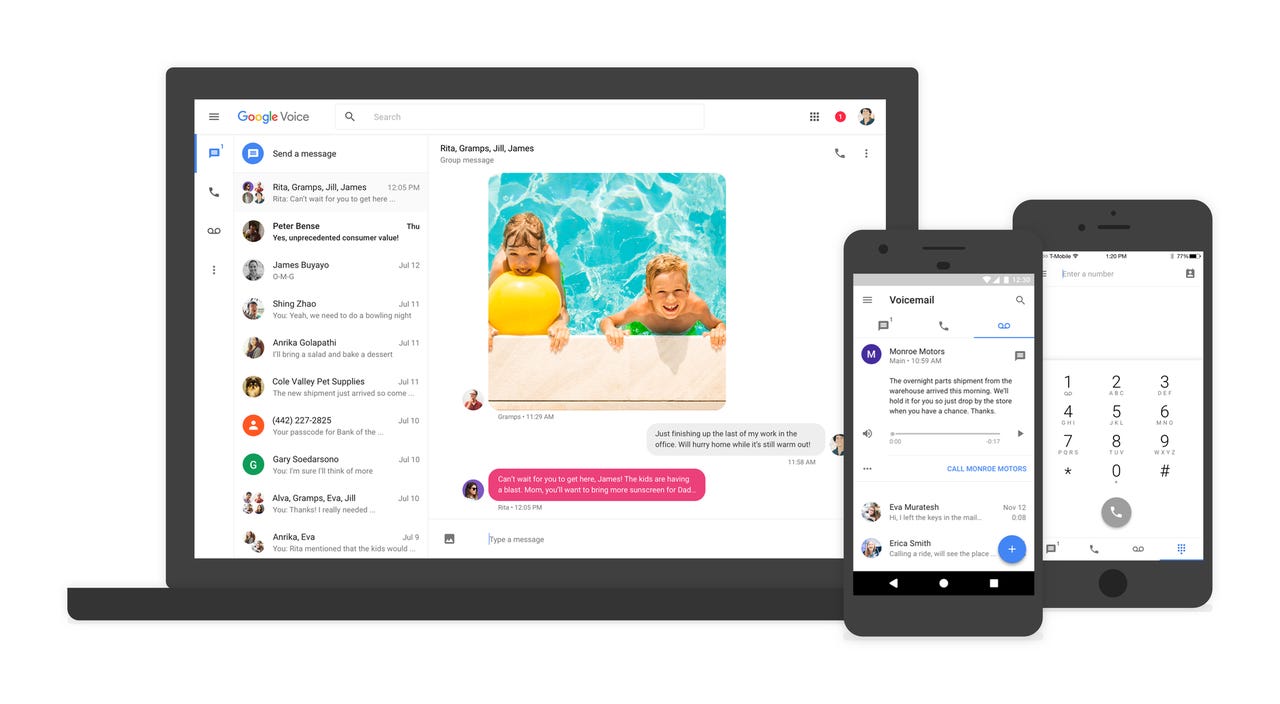Recent Google Voice updates are welcome additions


The new look of Google Voice across Android, iOS, and web.
When Google Voice launched in 2009, the free service targeted business users who wanted a second phone number for work, without the burden and cost of carrying around a second phone.
At the time, Google Voice lacked key features such as photo, video, and group messaging to truly replace carrier-assigned phone numbers, but it offered voicemail transcripts and scheduled auto-forwarding of phone calls. For those who wanted to control when and who could call them, it got the job done.
Then, Google forgot about Voice. Updates all but stopped, and with the rollout of Google's Project Fi wireless service, users were forced to give up Google Voice in order to sign up for the service. It appeared Google Voice would die a slow death, as many of the company's services have before it.
Last week, however, Google announced the first meaningful update to its Voice platform in five years. In addition to the update, Google promised it would continue to update Voice with new features moving forward.
After using it for a week, let's take a look at what's new and where it fits in Google's ever-confusing approach to messaging.
What's new?
Google Voice's new look means a new app icon.
The most noticeable change to Google Voice is the overall look and feel. Google revamped the entire layout of Voice, bringing it in line with the Material design Google has adopted on Android and across its web apps over the past few years. Three tabs separate messages, call history, and voicemail, making navigation easier than clicking or tapping on a series of links.
Cosmetics aside, Google Voice also gained photo and group messaging. Videos aren't supported yet, but hopefully that's something Google will include in a future update. These two features alone are something that many -- including yours truly -- had begged Google to add long ago, yet it never happened.
Welcome additions
Like many others I've talked with after the Google Voice update, I had stopped using my account years ago. With recent improvements and a stated interest in continuing to improve the platform, I started using it again.
I exchanged multiple text, photo, and group messages over the past week, and nearly all of them were delivered without issue. On a couple of occasions, I didn't receive a photo a contact said was sent, only to have it arrive later in the day. Google Voice has never been perfect in delivering messages on time, all the time.
The biggest annoyance of Google Voice is that read status doesn't sync between devices. For example, if I read a text message on the web, the Android and iOS apps still show I have unread messages. I have to manually open the app, then refresh the conversation or conversation list, and wait for the app to reflect the web. This lack of syncing works both ways, with the web sometimes not reflecting current conversations taking place within the app.
Another update that hasn't received a lot of attention is the fact that Google Voice for iOS now includes a native iPad app, not a scaled up version of the iPhone app, and it no longer requires you to verify an additional phone number when using it on the iPad.
Mastering Google Voice
Otherwise, Google Voice still works how it always has, only now you can share photos and GIFs with friends.
Where does it fit in Google's messaging landscape?
It doesn't, really.
Google's approach to messaging is spread out across several apps and services. There's Google Hangouts for instant messaging, Allo as an SMS replacement, Messenger for SMS, and Voice as an alternative phone number.
Each product has a different feature set that's used to attract the same users.
Combining all of these apps and services into a core product, say Allo, would eliminate user confusion and streamline the entire experience for the end user.
Allo, if you recall, is the messaging product that features Google Assistant. Users interact with Assistant in a private conversation, or during a conversation with a contact, Assistant will occasionally surface relevant information, offering to make reservations, for example.
We know Google's annual developer conference, Google I/O, is scheduled to take place May 17 through May 19 at the Shoreline Amphitheater next door to the Google campus.
Perhaps announcing the first update to Google Voice now, and promising future updates and improvements, was the first step toward unifying the messaging mess Google has created. If so, it's possible we will hear more about the company doing just that at Google I/O this year.
Then again, your guess is as good as mine.
Google goes completely green to tackle climate change: